✅🌸 Unit One - Biological Pillar (Part 1: Brain, Neurons, Nervous System, Drugs)
1/94
There's no tags or description
Looks like no tags are added yet.
Name | Mastery | Learn | Test | Matching | Spaced |
|---|
No study sessions yet.
95 Terms
What are biopsychologists?
They study the human brain and how it impacts human BEHAVIOR
What type of cells make up the Nervous System?
Neurons (primary cells) and Glia (support cells)
What are glia and their function?
They are nervous system cells that SURROUNDS neurons/support them (like glue)
What is the difference between sensory neurons and motor neurons?
Which direction (from/to the brain) do sensory and motor neurons send their signals?
Sensory neurons - receive and bring sensory info TO THE BRAIN (touch, sounds, heat, light, taste, smell)
Motor Neurons - carry motor info FROM THE BRAIN to the muscles (to tell them to move) ; muscle memory
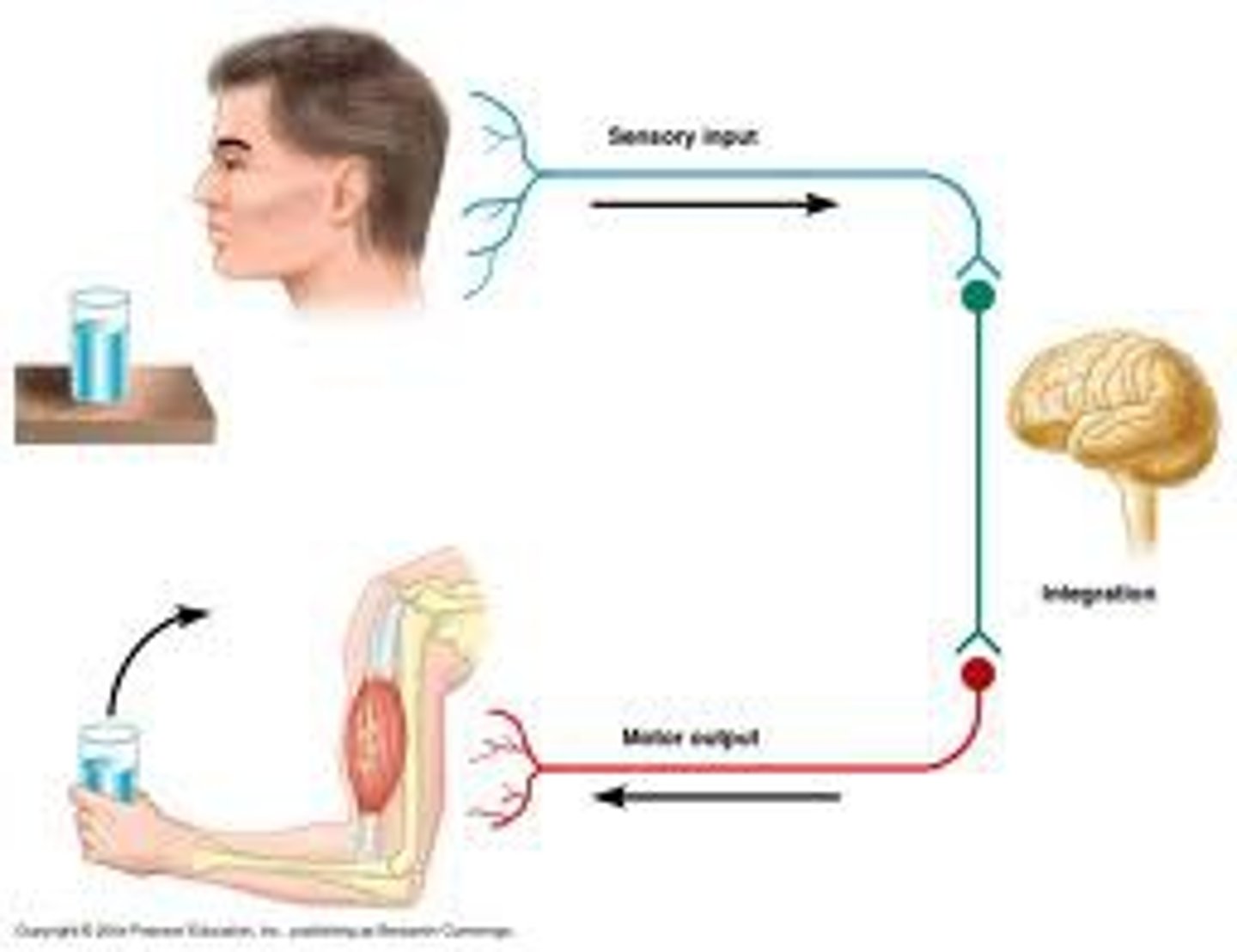
What is a interneuron?
They connect sensory and motor neurons in the brain and spinal cord (responsible for reflex arc)
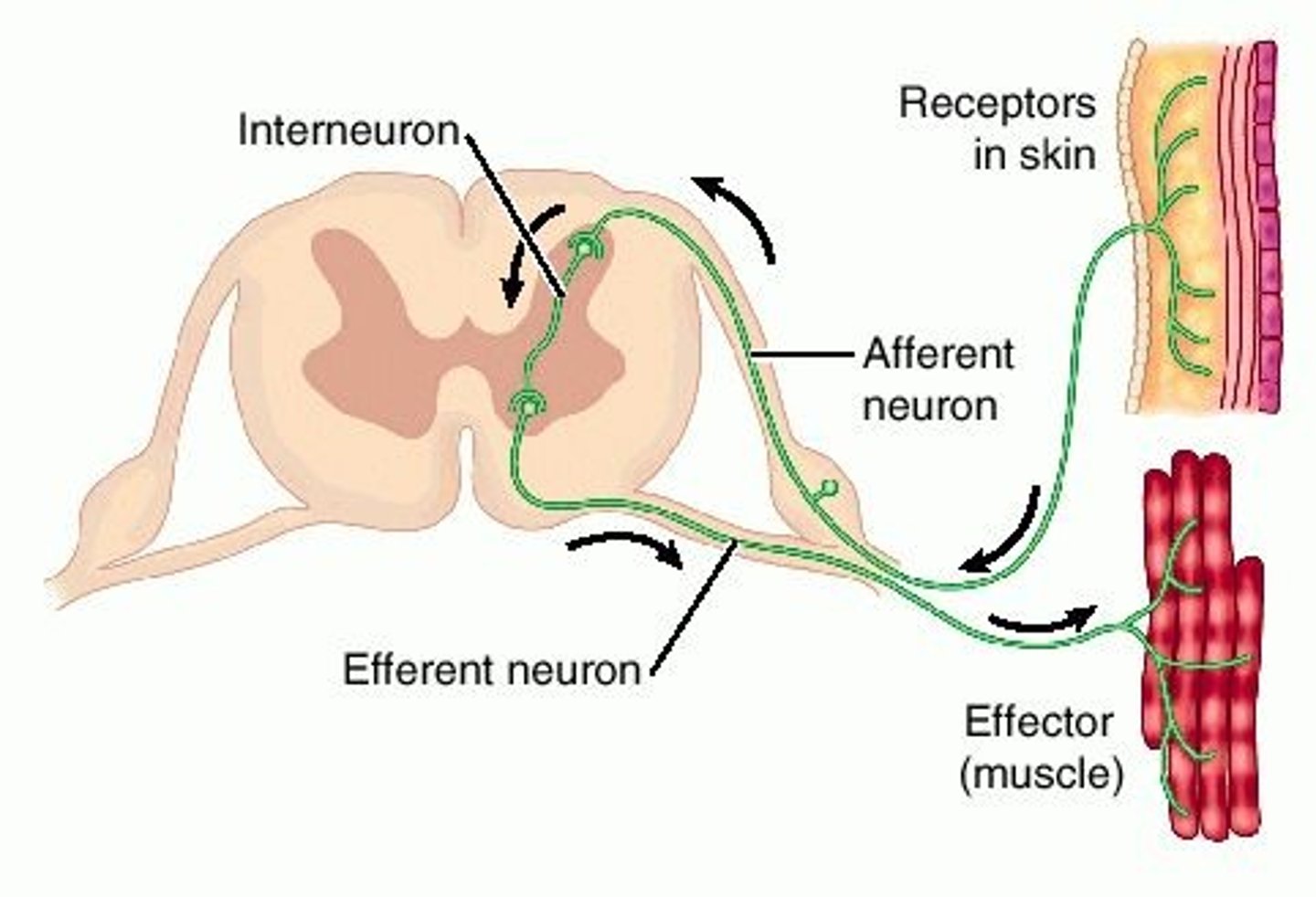
What is a reflex arc?
An involuntary reflex/response to stimuli on the body. GOES TO SPINAL CORD
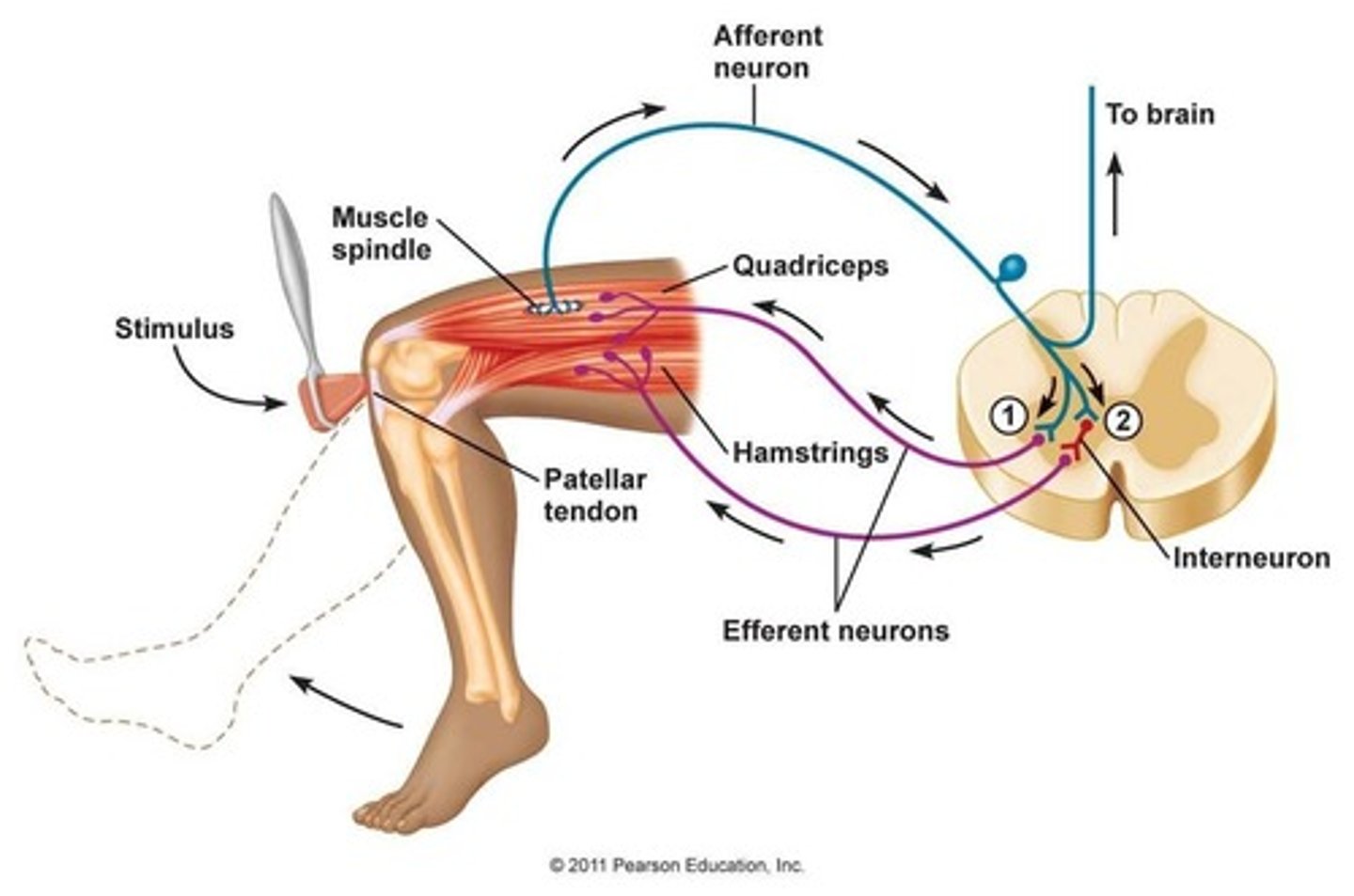
What research techniques do we use to study the brain?
EEG and fMRIS
What is a brain lesion? How do they occur?
Region of the brain that has been damaged
- HUMANS: damage occurs by natural diseases/trauma (never done on purpose)
- ANIMALS: damage is done on purpose
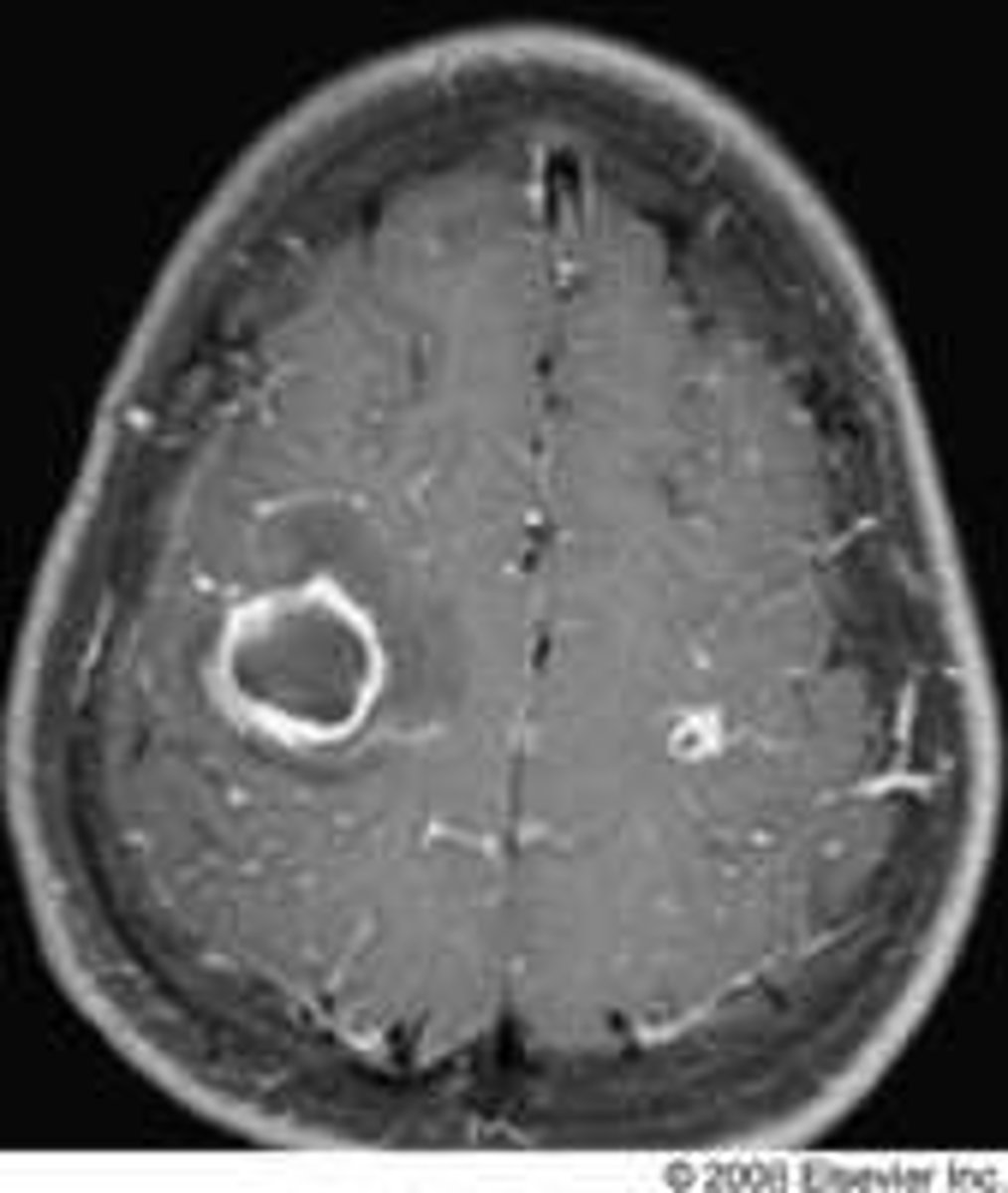
What is a lesion?
Damage on the brain
Verb: causing damage to the brain on purpose (only ANIMALS)
What's an EEG and what is the disadvantage of using them? Do we use this on humans or animals?
A recording of the activities in the brain / shows us how active the brain is IN HUMANS
Disadvantage: doesn't show you where the activity is occuring
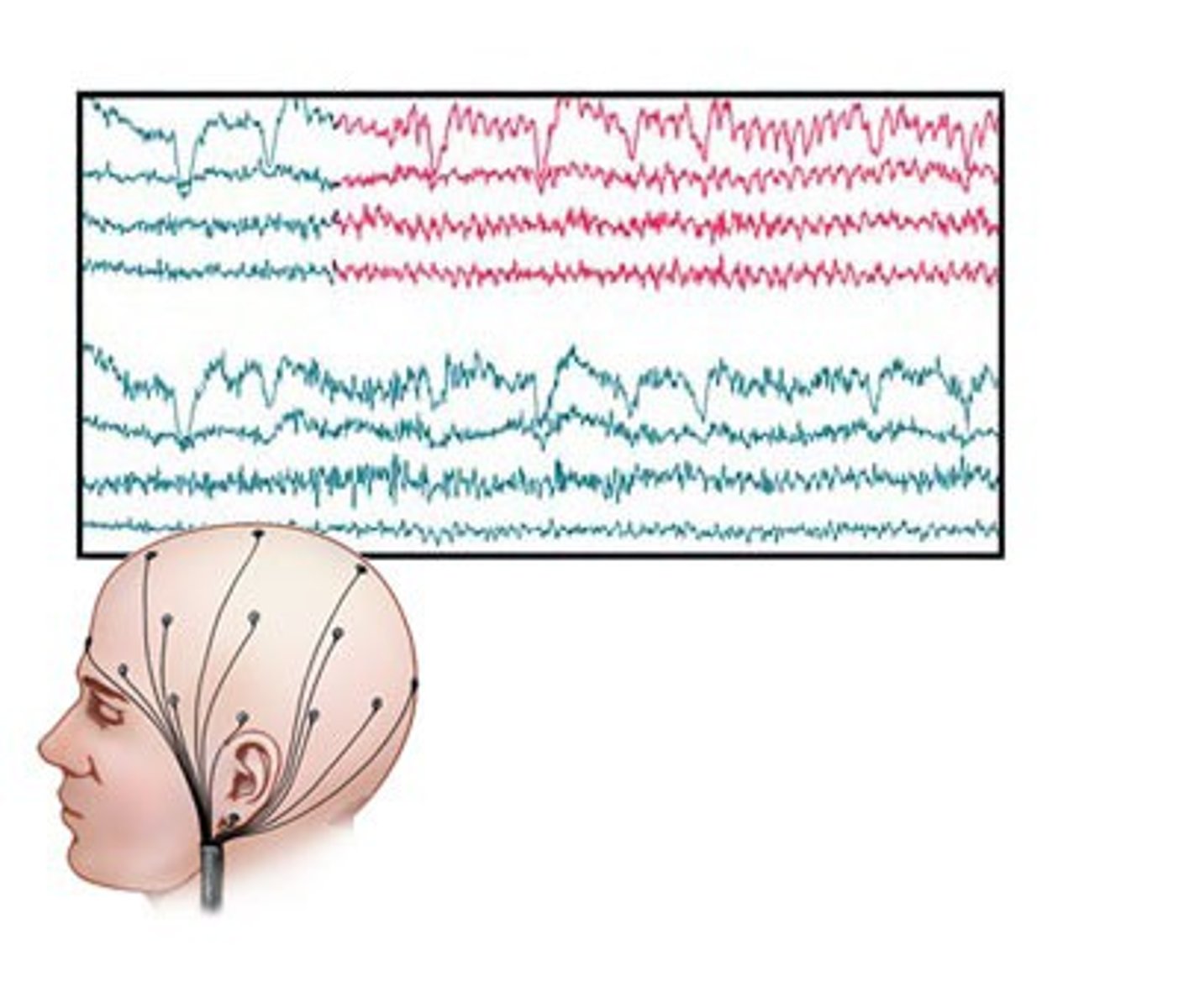
What do fMRIs show? How do they work?
fMRIs show brain activity in real time (pictures of where activity is happening). They work by the use of magnets which ping oxygen by neurons
(mostly in humans)
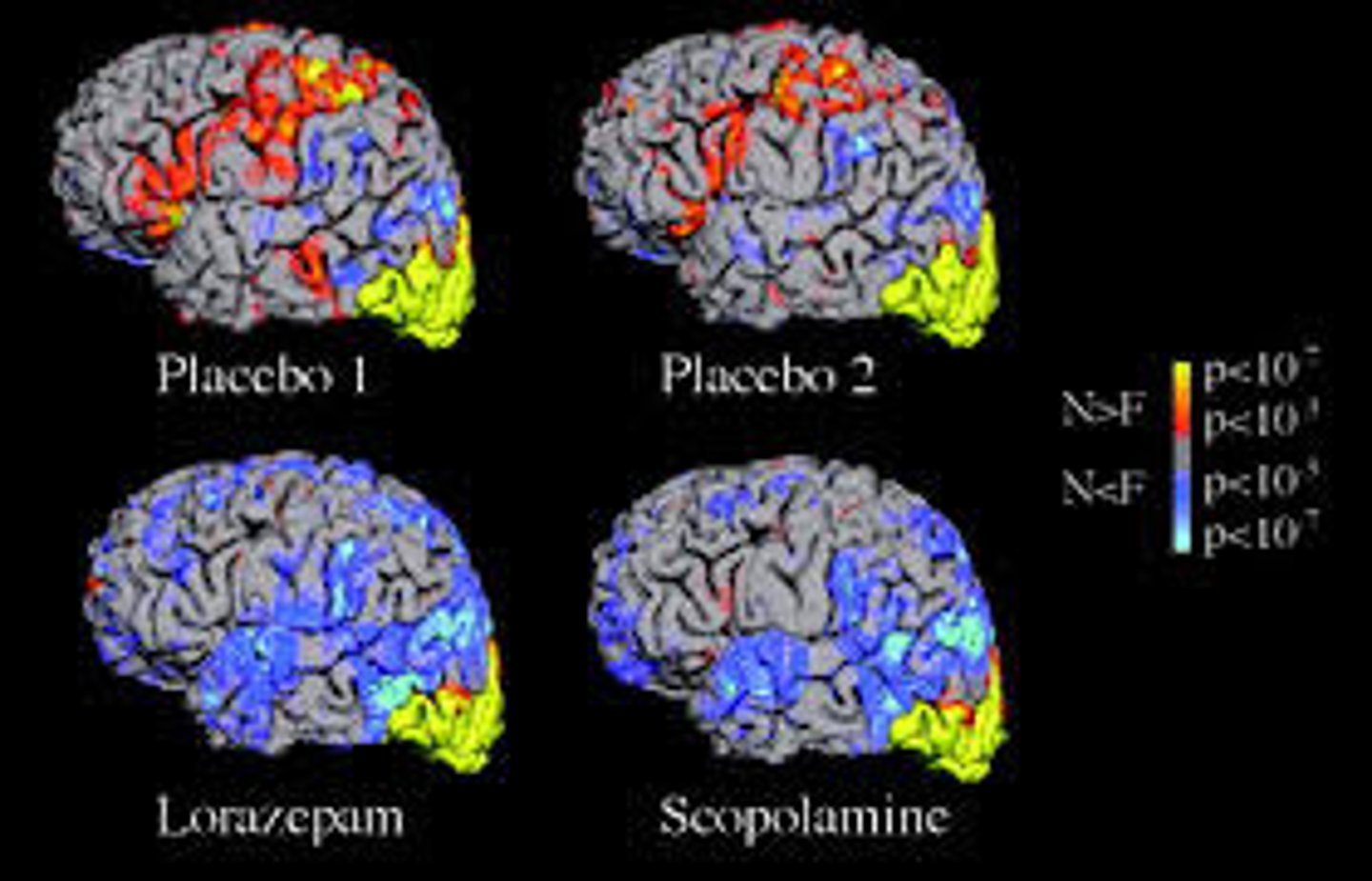
What is the function of the brain stem?
Responsible for vital life functions like breathing and heart rate(+ sleep, etc)
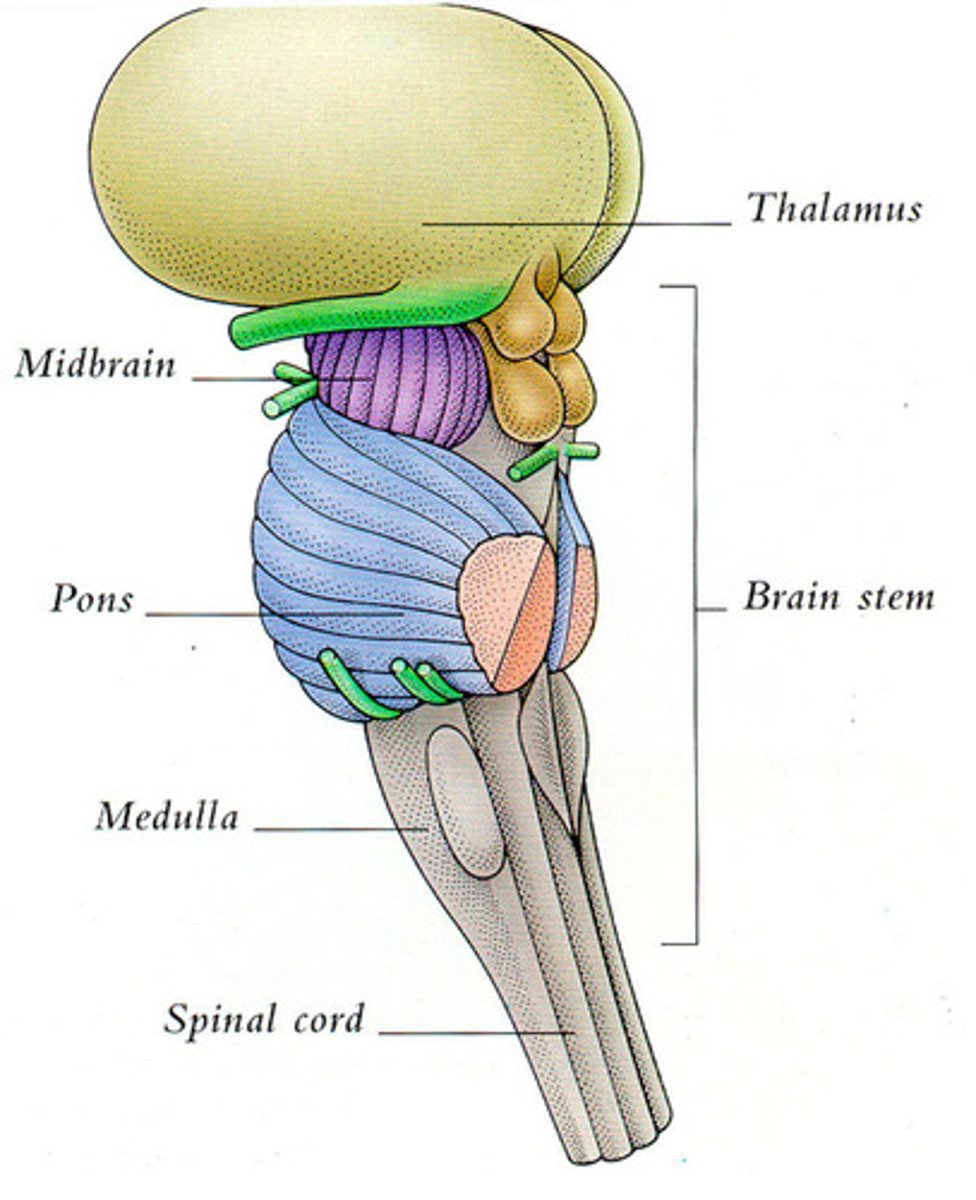
What is the function of the medulla?
It is a part of the brain stem and is responsible for cardiovascular and respiratory systems (breathing, circulation, heart...)
EXAMPLE: regulates breathing, sneezing, swallowing, heart, and blood vessal function, and digestion
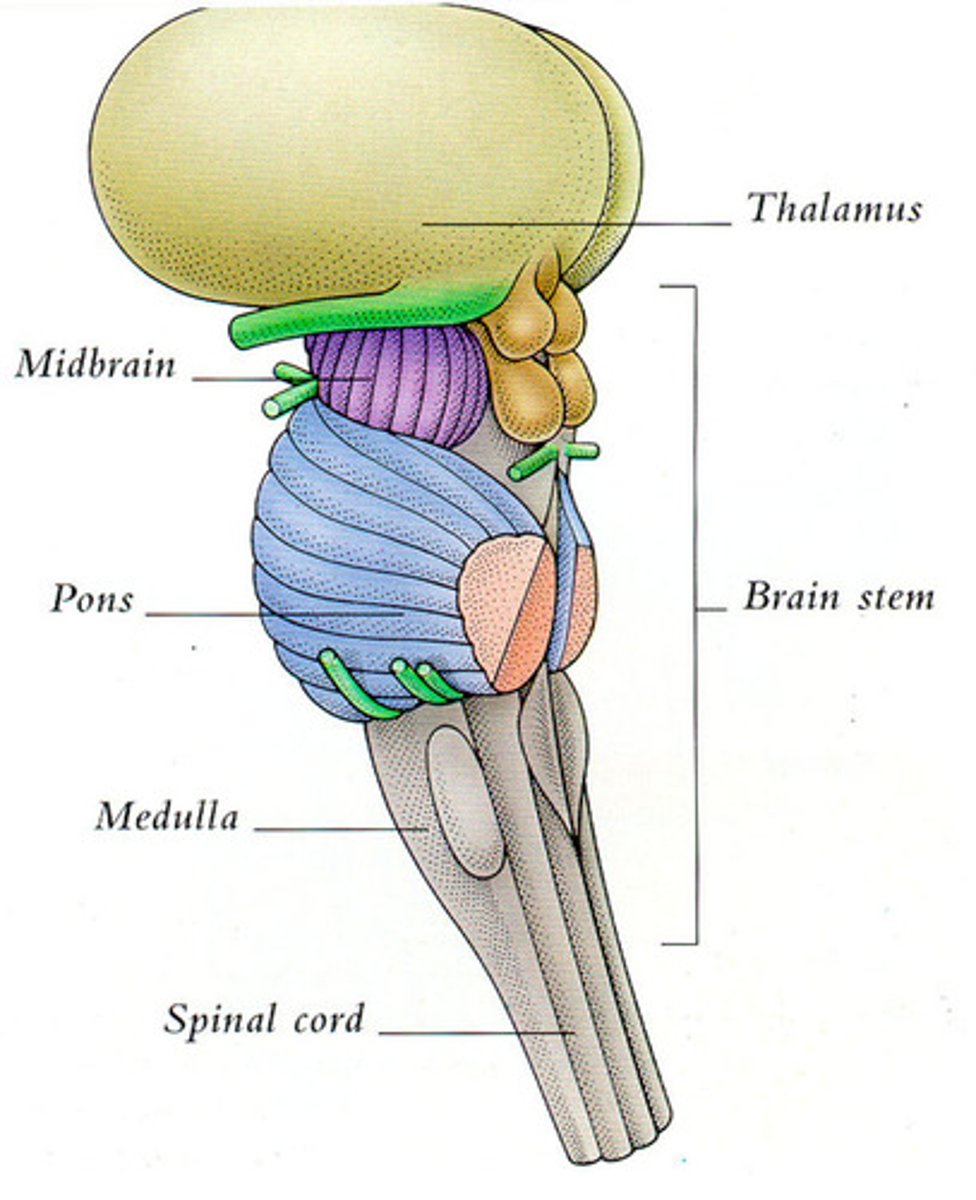
What is the function of the RAS (reticular activity system)?
Maintains consciousness such as sleep/wake pattern, attentional focus/awareness, eye movement, SOME voluntary movement
What is the function of the cerebellum? (know location)
Responsible for motor coordination and balance
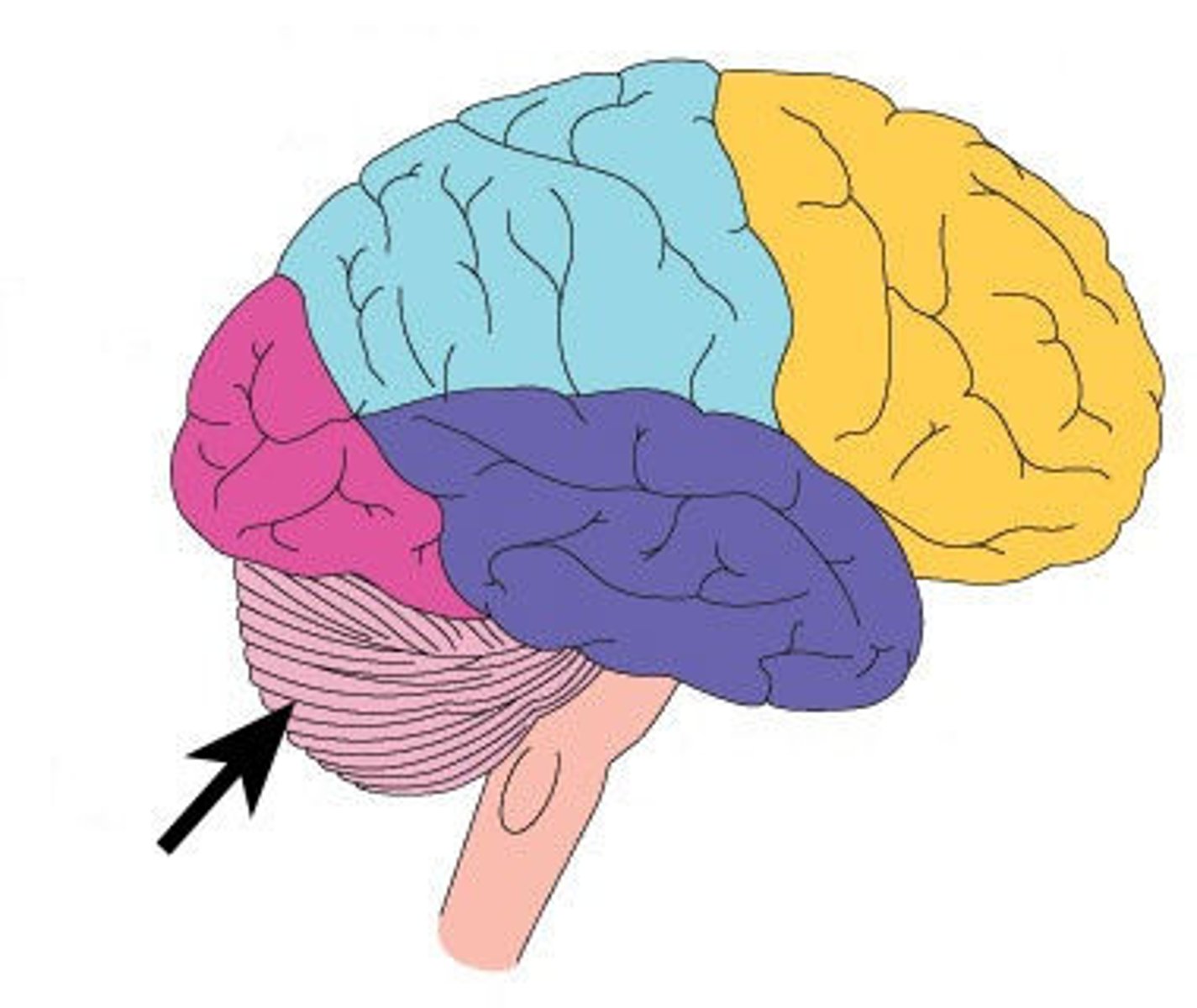
What is the function of the thalamus? What sensation does NOT route through the thalamus? What is the official name of this?
RELAYS SENSORY AND MOTOR SIGNALS to the appropriate brain area FOR ALL SIGNALS (expect smell - official name: olfaction)
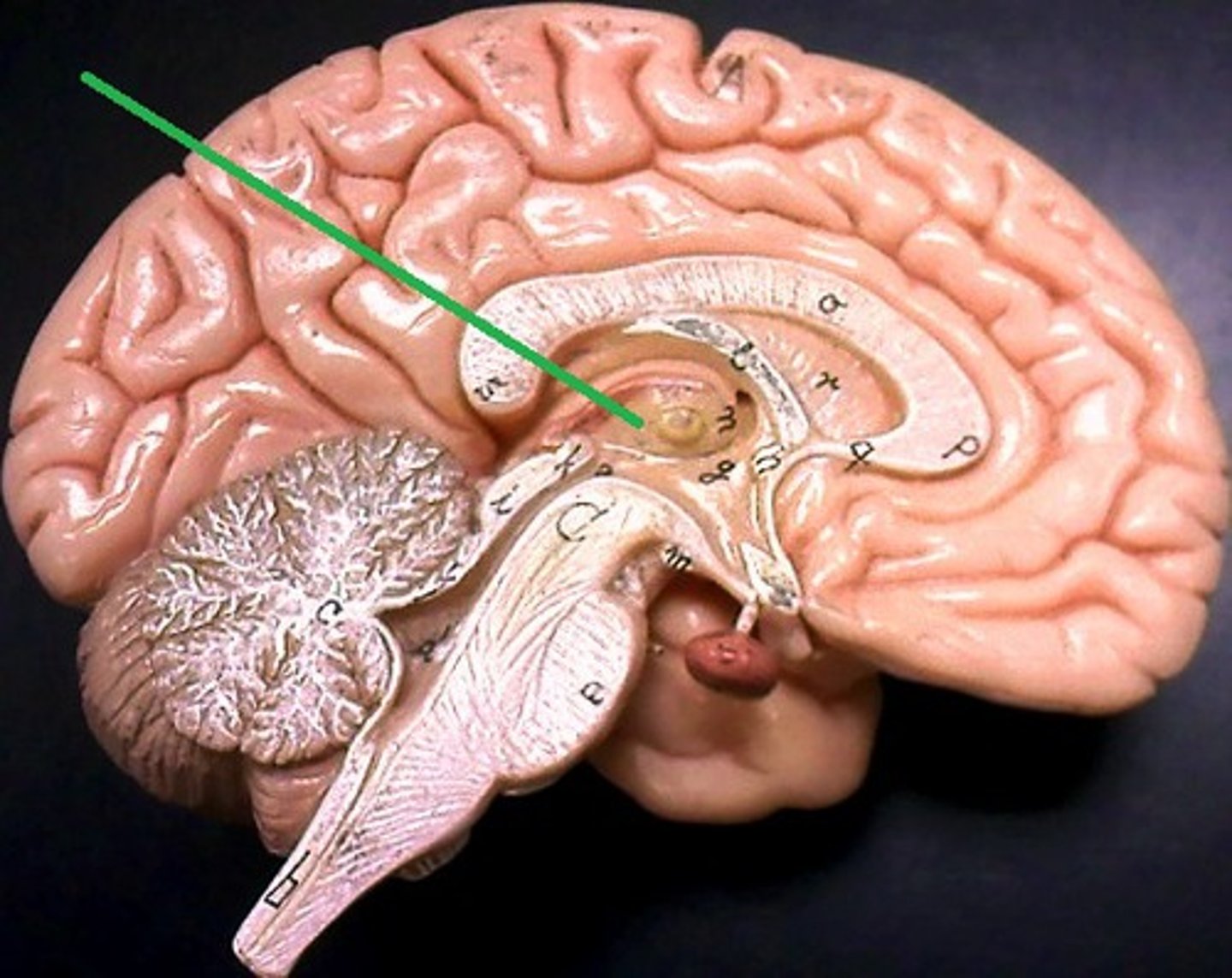
What is the function of the amygdala?
center of emotions (FEAR!!!!)
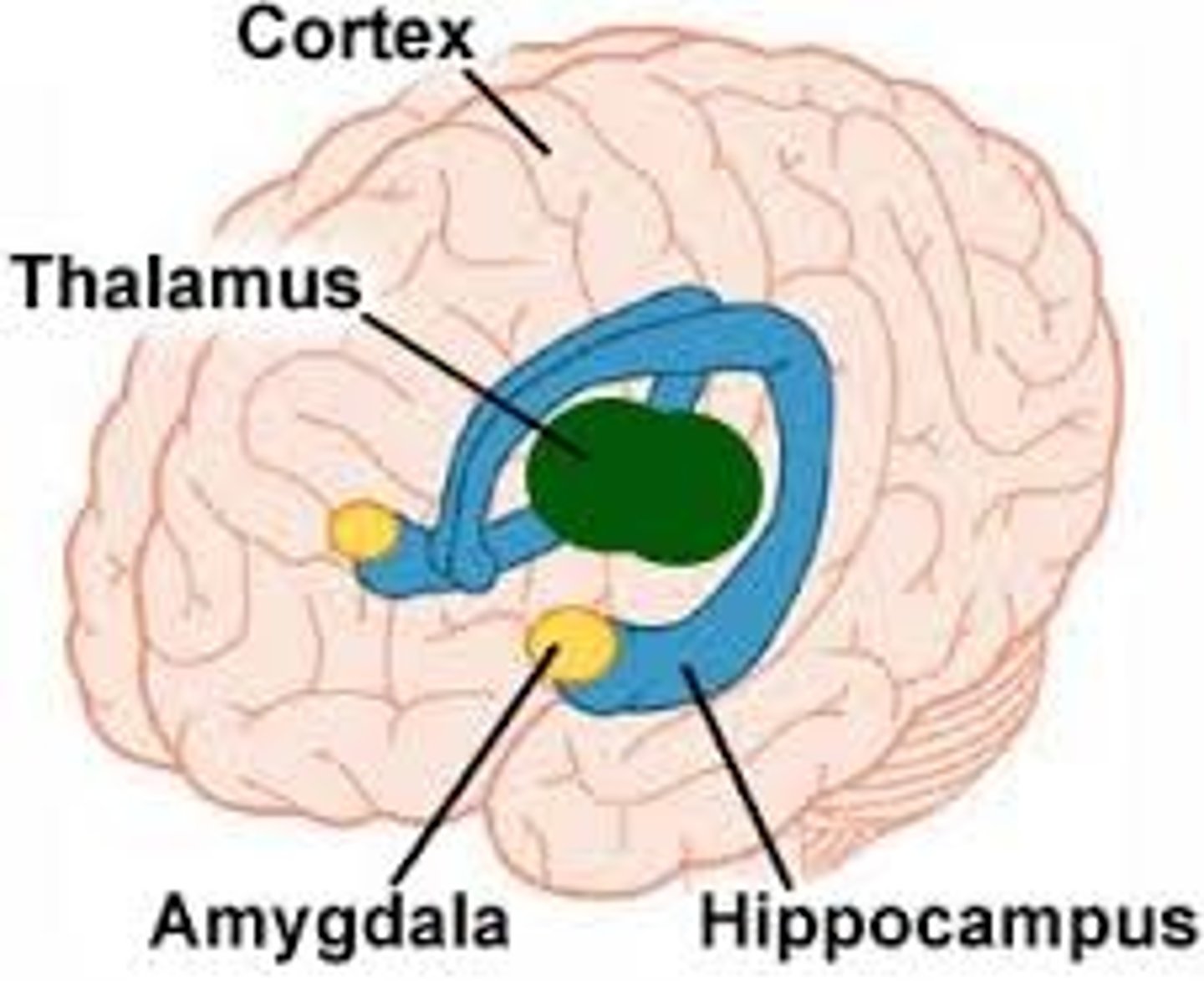
What is the function of the hippocampus?
memory storage for life events and factual information (non-skilled based memories)
EARLY + LONG-TERM MEMORY (+ spatial navigation)
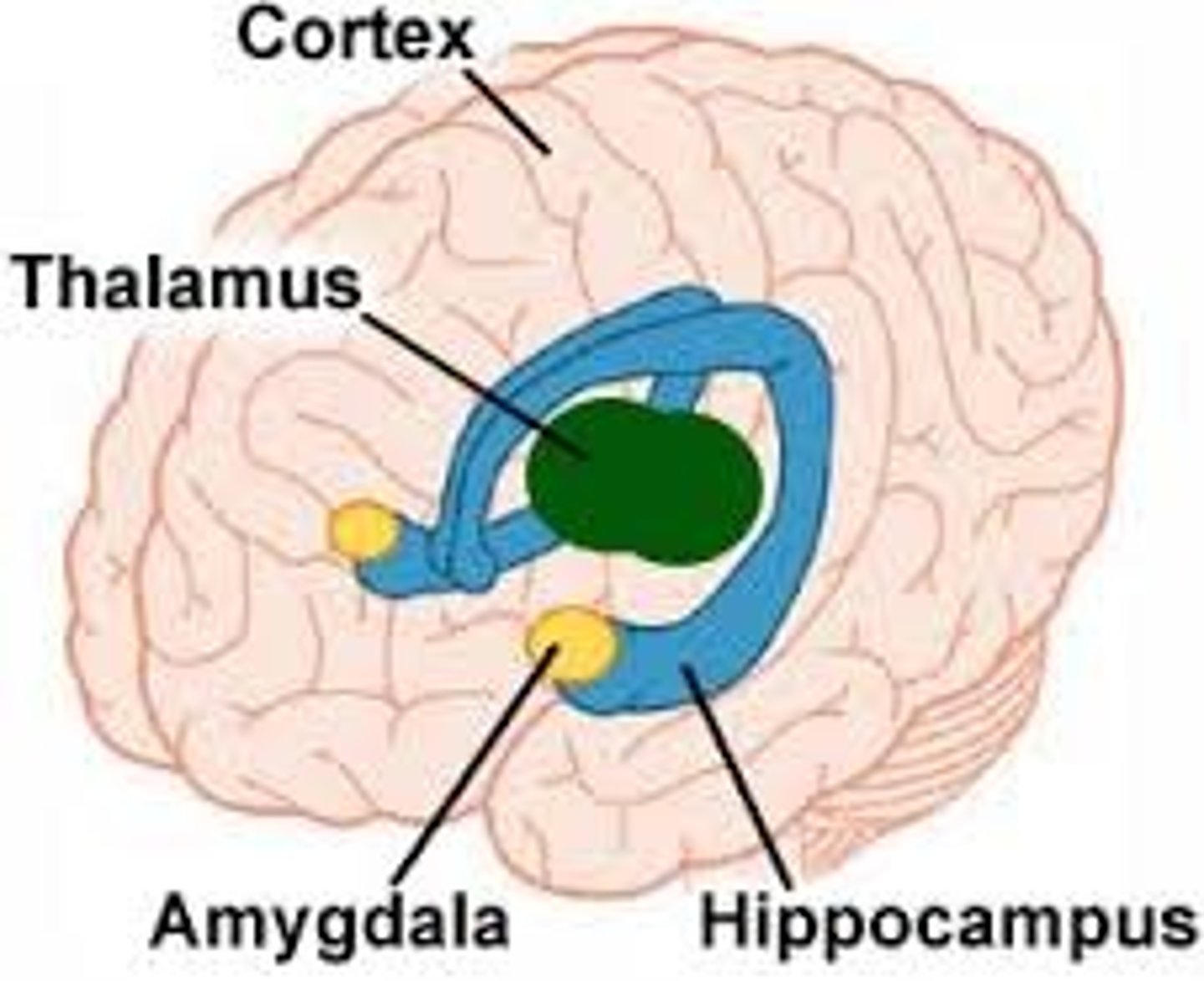
What is the function of the hypothalamus?
Involves:
1. Homeostasis
2. Hormone control
3. Eating behaviors
4. Reward center of brain / (addiction center)
Example: hunger/thirst, sexual activity, temp, heart rate, shivering
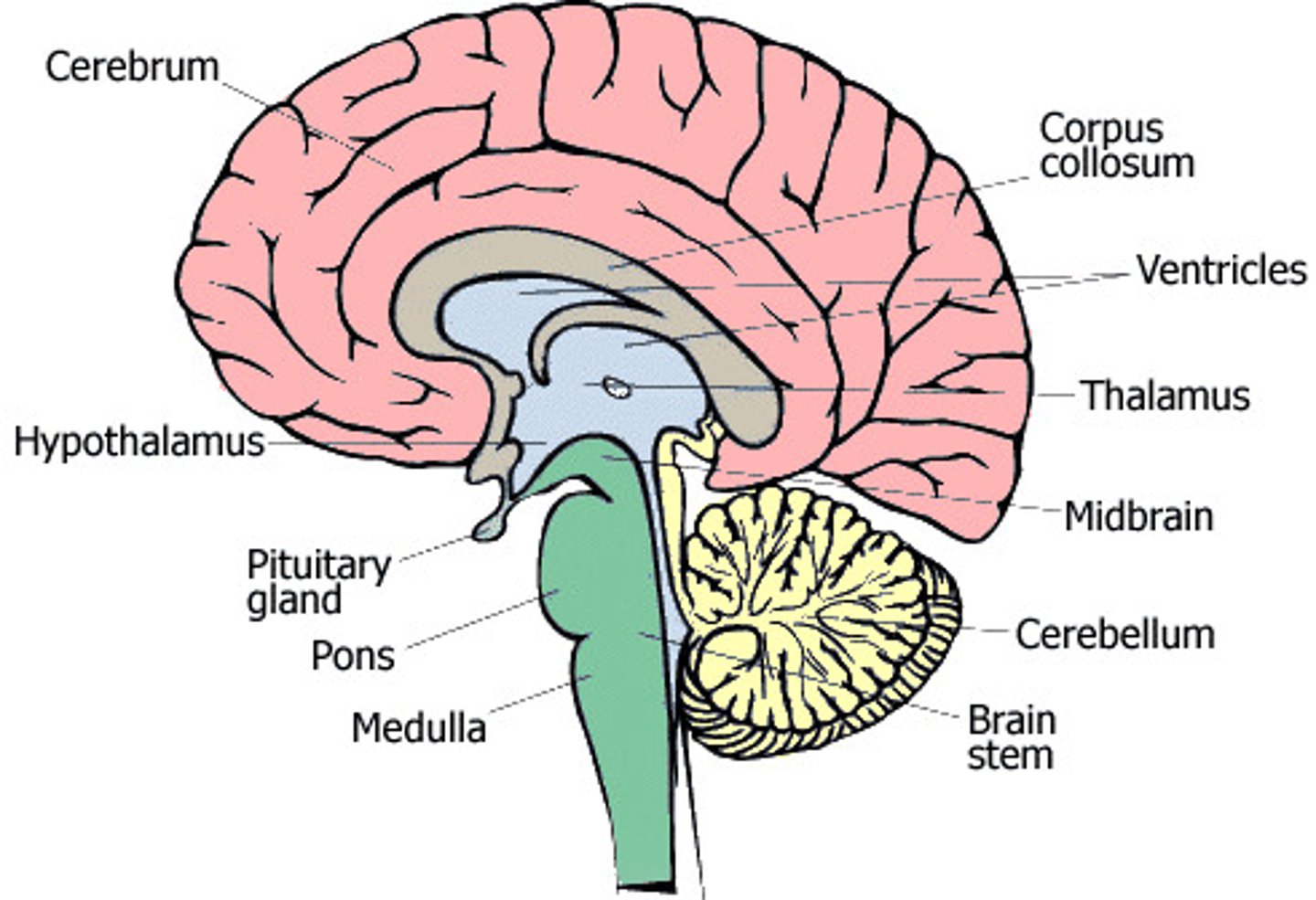
What is the function of the pituitary gland?
- produces/releases hormones (master gland)
- communicates with the hypothalamus and endocrine system
secretes hormones to be distributed throughout the body
What is the limbic system, and what brain regions make up the limbic system?
- Amygdala, hippocampus, hypothalamus
Emotions, motivations, memories
example: processing/regulating emotions, sexual arousal, and memories
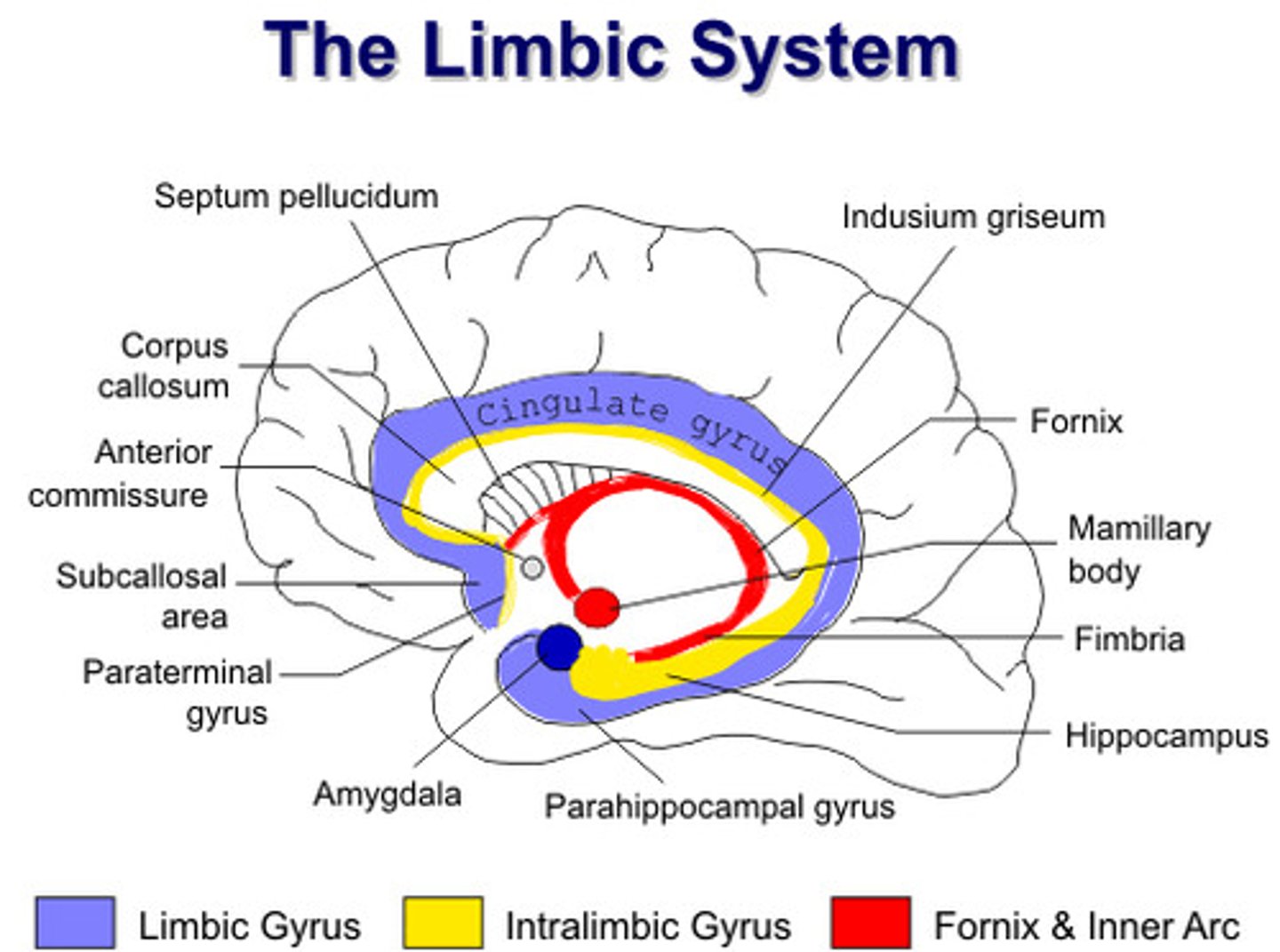
What is the cerebral cortex?
the outer most layer of the brain (contains your lobes) - biggest part of the brain
example: auditory, sensory, cognitive, and visual information processing all fall under cerebral cortex in general (because auditory comes from [temporal], sensory [parietal], cognitive processing [frontal lobe], and visual information processing [occipital])
![<p>the outer most layer of the brain (contains your lobes) - biggest part of the brain</p><p>example: auditory, sensory, cognitive, and visual information processing all fall under cerebral cortex in general (because auditory comes from [temporal], sensory [parietal], cognitive processing [frontal lobe], and visual information processing [occipital])</p>](https://knowt-user-attachments.s3.amazonaws.com/c2b14ea6-745b-4349-a9b5-9d6bbc006855.jpg)
What are the four lobes? What are their functions? Where are they located?
Frontal lobe: front of the brain
Parietal lobe: behind the frontal lobe, above the temporal lobe
Occipital lobe: back of the brain
Temporal lobe: side of the brain, above the ear (on the 2D image, it is at the bottom of the brain)
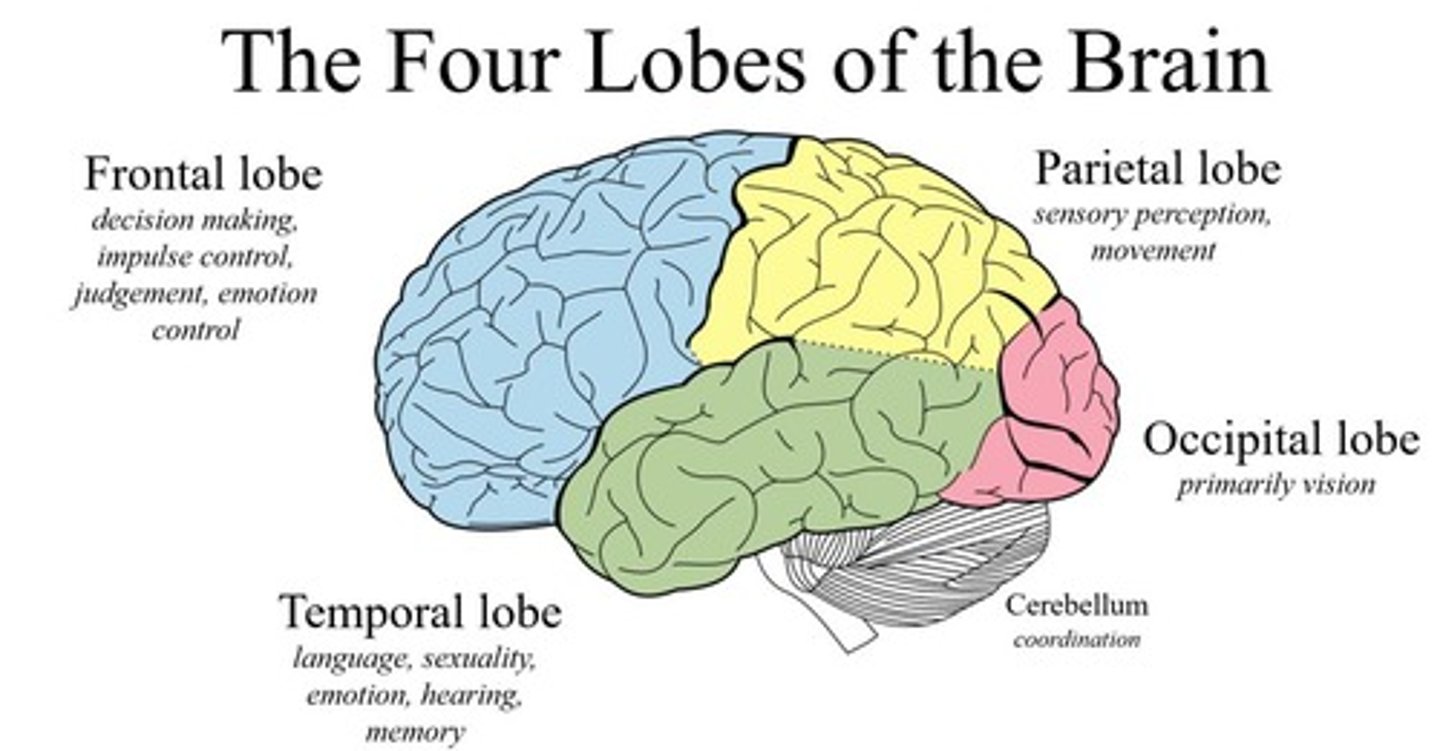
What are the functions of the frontal lobe?
Frontal lobe:
1. language PRODUCTION
2. higher-order thinking (critical thinking and creativity)
3. executive functioning [prefrontal cortex]
4. movement [primary motor cortex]
What is the function of the parietal lobe?
- touch sensations (contains somatosensory cortex)
What is the function of the occipital lobe?
vision
What is the function of the temporal lobe?
1. audition (hearing)
[remember it as: ears on the side of the head like the temporal lobe]
2. language PROCESSING
[remember it as: frontal lobe is at the front so it is the first step, temporal lobe is "behind" so it is the second step]
3. face recognition [connected to prosopagnosia if one cannot recognize faces]
4. memory (contains PART of the hippocampus)
What is the prefrontal cortex? Where is it located?
executive functioning
(anterior/front of the frontal brain)
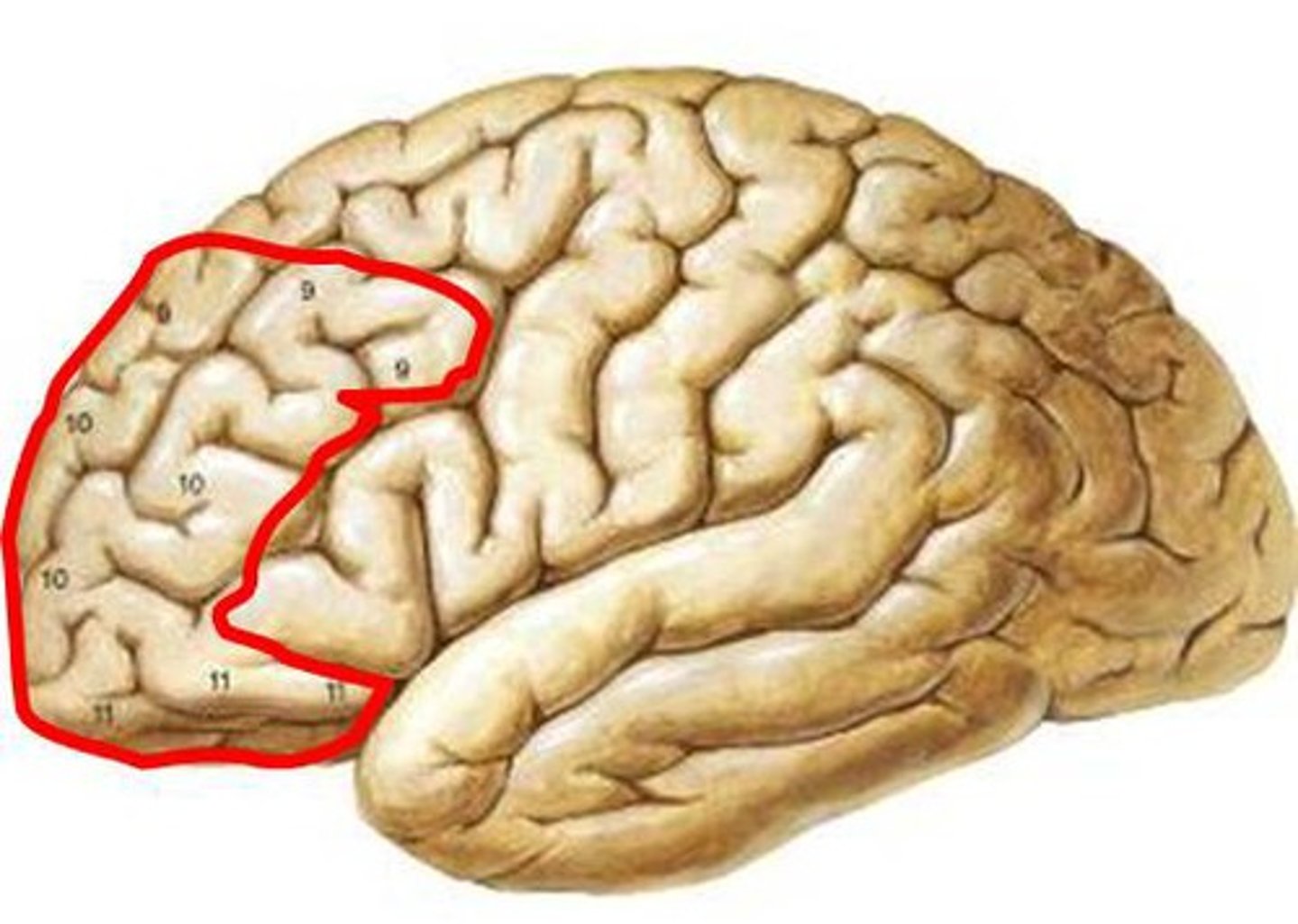
What is the primary motor cortex? Where is located?
responsible for skeletal movement - every motor neuron SENDS A SIGNAL to a designated spot in the motor cortex
(back/posterior of the frontal lobe)
motor cortex: generates neural impulses to control movement execution

List the 8 factors of executive functioning
1. impulse control
2. emotional control
3. flexible thinking (adjust behavior to unexpected charges)
4. memory (for key info)
5. self-monitoring how one is doing at the moment
6. planning and prioritizing
7. task initiation
7. organization (keep track of things physically and mentally)
What is the somatosensory cortex? Where is it located?
Contains every touch-specific sensory neuron (each has a designated spot in the somatosensory cortex)
(Parietal lobe)
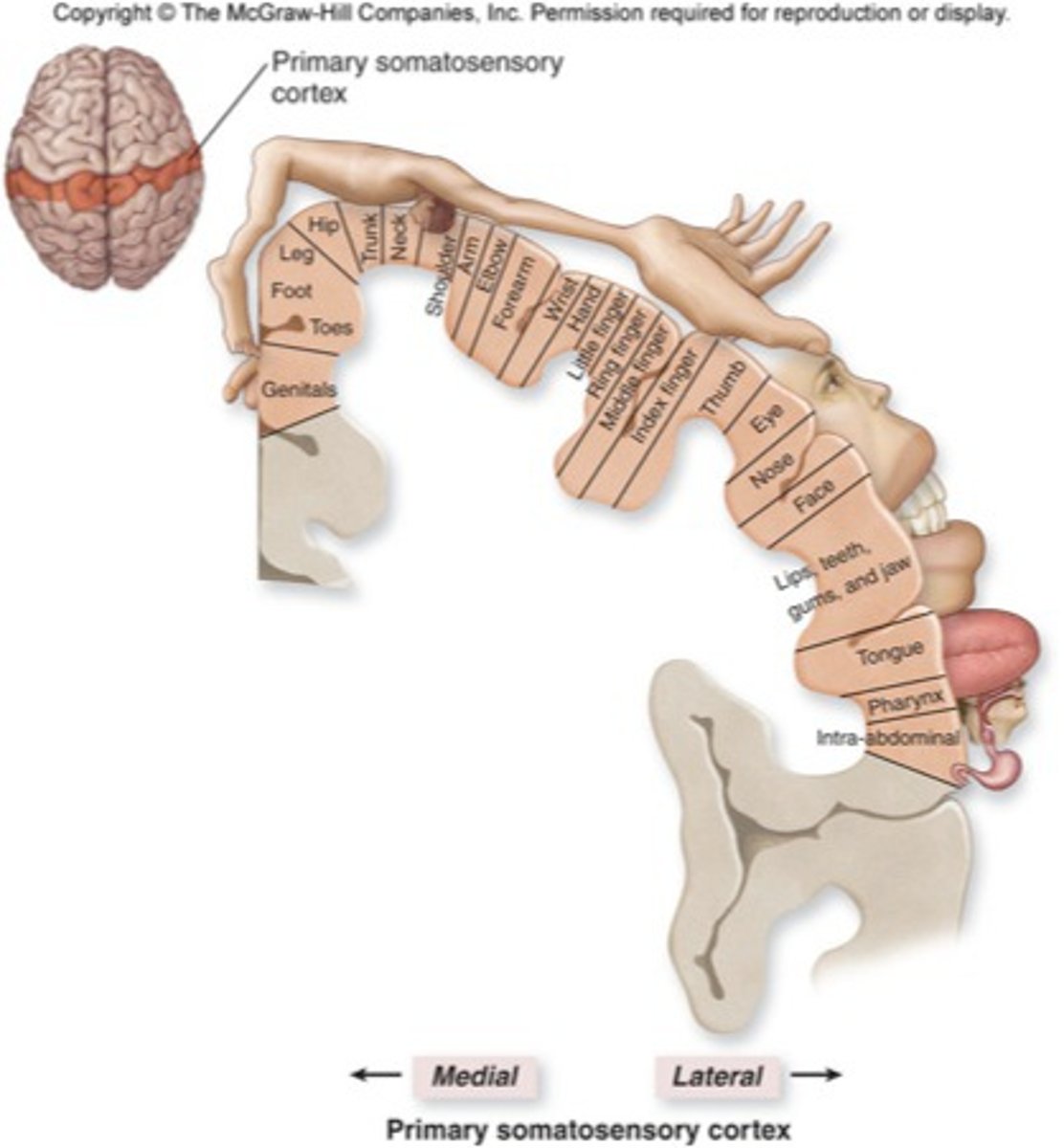
What is propsoagnosia?
inability to recognize faces due to LESIONS of TEMPORAL LOBE or genetics
What is aphasia?
loss of speech functioning (damage to one or more of the language areas of the brain)
What is the function of Broca's area? Which lobe is each a part of? Left or right?
- loss of SPEECH PRODUCTION
- left FRONTAL lobe [since the frontal lobe is language production AND the left hemisphere = speech properties]
remember as: Broca = Broc = Broke = Broken (broken speech)
ex: "Yes... ah... Monday.. er... Dad... and Peter H.... Wednesday... nine oclock..."
What is the function of the Wernicke's area? Which lobe is each a part of? Left or right?
- loss of SPEECH COMPREHENSION
- left TEMPORAL lobe [since the temporal lobe is language processing AND the left hemisphere = speech properties]
speech jumbled together
ex: "I called my mother on the television and did not understand the door. It was too breakfast, but they came far to near. My mother is not too old for me to be young"
What is the function of the corpus callosum?
connects the two hemispheres of the brain (left and right) and allows for them to communicate w/ each other
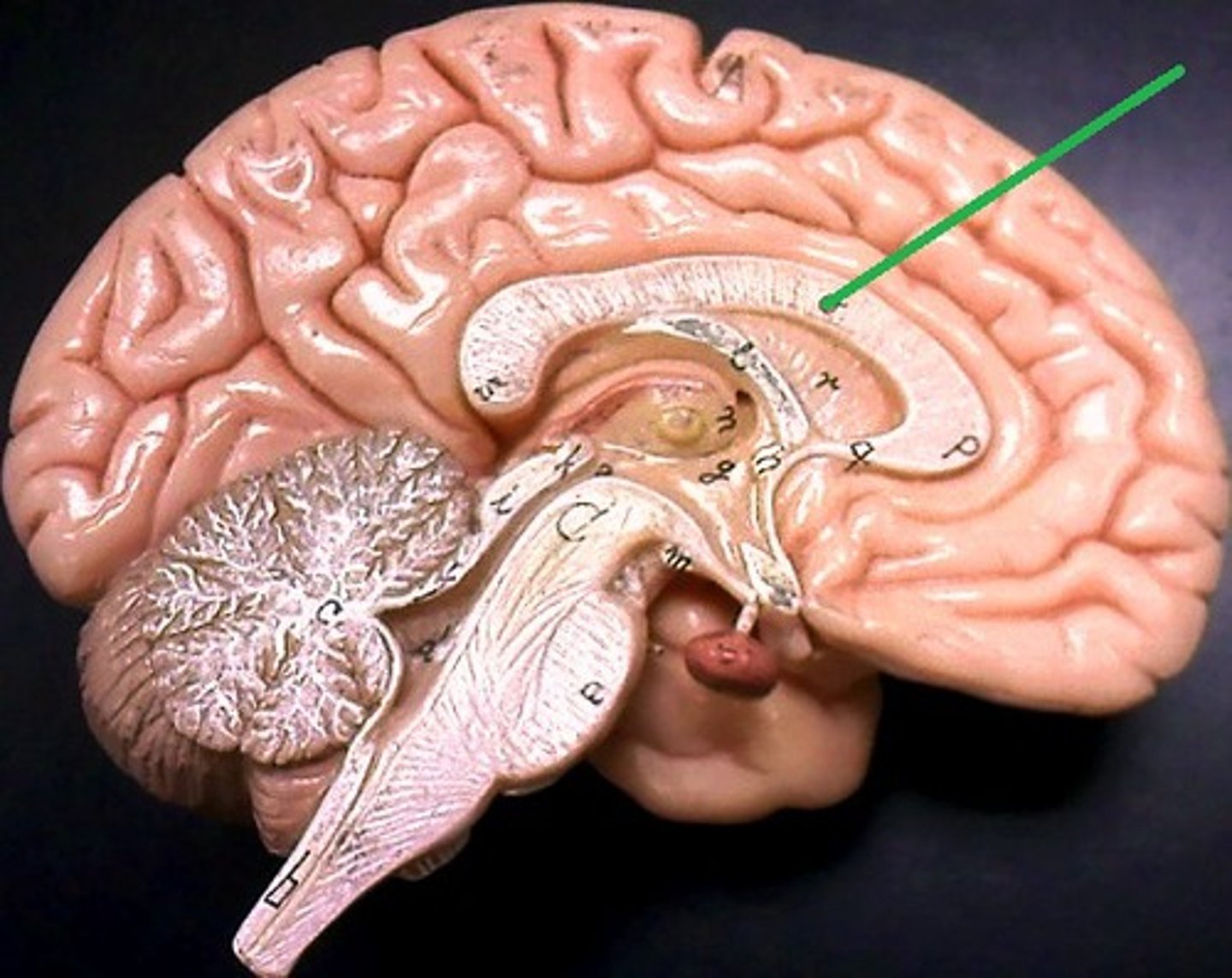
What are association areas?
parts of the cerebral cortex that RECEIVE input from multiple areas (they usually integrate info)
like a mix of everything idek
What is blindsight and what causes it?
a condition where someone can perceive the location of an object despite being cortically blind
- caused by lesions to the primary visual cortex (in occipital lobe)
(eyes and other regions of the brain are still intact)
[example: people will catch a ball & be able to identify movement despite being blind]
- evidence of association areas still processing relevant information
What does plasticity mean?
the brain's ability to heal from damage and change from damage/experience
example: use brain plasticity in children who have had a brain hemisphere removed
How does plasticity happen? Explain how the brain changes and substitutes functions to heal
Neurons grow more branches to take up the empty spaces. Because the brain was damaged, the brain will reorganize the somatosensory OR motor cortex in response to the changes in the sensory/motor neurons -> other brain areas will take over the damaged functions ??????????????? ask ms thompson cuz wat theuwhjhka
Define neurogensis
the regrowth of neurons
What is phantom limb pain?
after amputation of a limb, a person continues to still feel pain (and other sensory feedback) from the lost limb
Which side of the brain controls the left side of the body? And vice versa?
- the right side of the brain controls to left side of the body
- the left side of the brain controls the right side of the body
Describe the split brain experiment
the two hemispheres will function independently if the corpus callosum (connection) is severed/cut off
.. this will lead to separate functioning
> left visual field = processed by right hemisphere
> right visual field = processed by left hemisphere
> left hemisphere: language/speech - can name/explain objects (will use right visual field to visual)
> right hemisphere: spatial awareness/recognition of visuals/faces - cannot verbally describe an object BUT could point/draw the object with left hand (has the left visual field which cannot visual)
What is lateralization?
the brain separates some functions into predominately left or right hemispheres
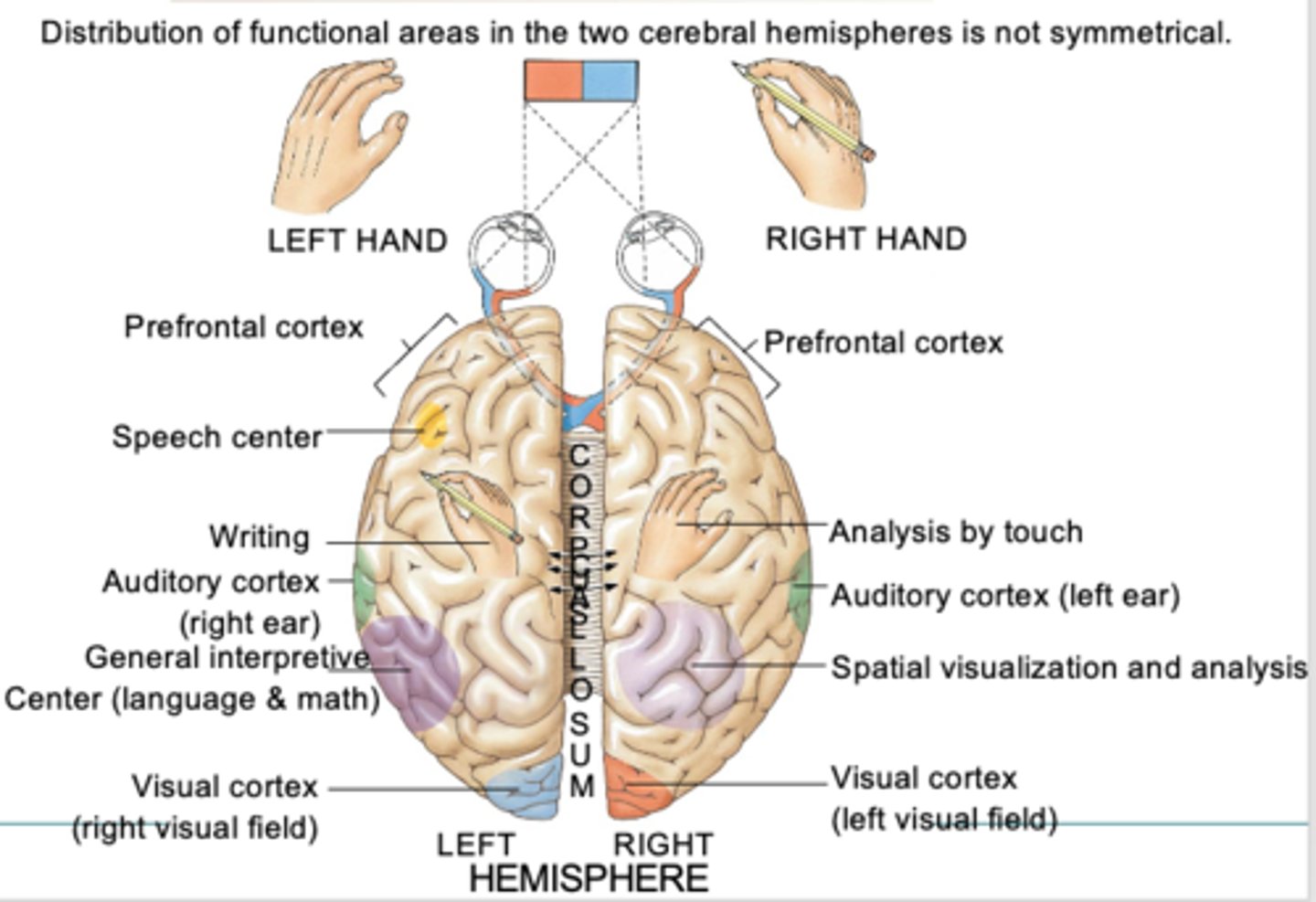
What is the myelin sheath and the role of it? Where is it?
It is a glial cell (technically a Schwann cell)
- protects the axon + speeds up the signal
- not all cells have this!!
- MULTIPLE SCLEROSIS is caused by the destruction of the myelin sheath
[ myelin sheath = ms, multiple sclerosis = ms ]
![<p>It is a glial cell (technically a Schwann cell)</p><p>- protects the axon + speeds up the signal</p><p>- not all cells have this!!</p><p>- MULTIPLE SCLEROSIS is caused by the destruction of the myelin sheath</p><p>[ myelin sheath = ms, multiple sclerosis = ms ]</p>](https://knowt-user-attachments.s3.amazonaws.com/d25ad9ad-c299-4d0e-b56c-f14cae8a6ba8.png)
What causes multiple sclerosis and what are the symptoms?
- the destruction of the myelin sheath CAUSES multiple sclerosis
- symptoms: vision problems, fatigue, pain, movement issues
What are the two nervous systems? What are their functions?
central nervous system: brain and spinal cord
peripheral nervous system: how your brain receives sensory information and controls all of your muscles (motor)
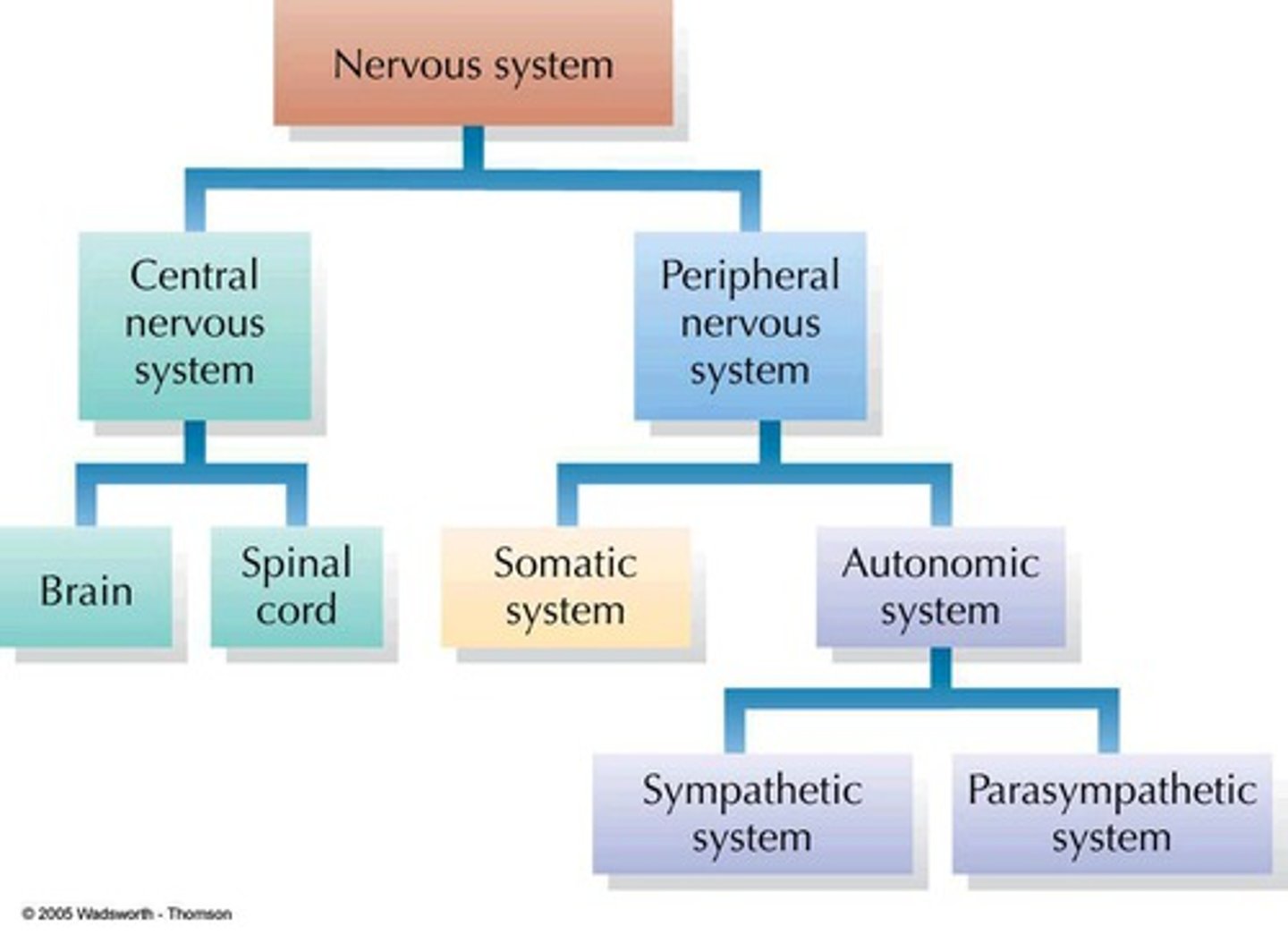
What are the two nervous systems that FALL under the PERIPHERAL NERVOUS SYSTEM? What do they do?
autonomic nervous system: communicates with internal organs and GLANDS
somatic nervous system: communicates with sense organs and VOLUNTARY muscles
What divisions are a part of the autonomic nervous system? What do they do?
sympathetic: arousing/increases energy - FLIGHT OR FIGHT
- increase in pupil dilation, airways dilation, and heart (fast heartbeat)
- decrease in digestion and bladder relaxation
parasympathetic: calming/decreases energy - REST/DIGEST
- increase in digestion stimulation and bladder constriction
- decrease in pupil constriction, airways constriction, and slow heartbeat
What divisions are a part of the somatic nervous system? What do they do?
sensory (afferent = carrying toward) nervous system: sensory input
motor (efferent = carrying out) nervous system: motor output
What is the autonomic nervous system responsible for?
The 4Fs:
1. fight
2. flight
3. feeding
4. fornicate
What is meant by communication in an electrochemical process?
SIGNALING is an electrochemical process
signaling = the transmission of information through the movement of ions and electrons
Neurons communicate through an electrochemical process. An electrical SIGNAL is triggered to be generated through the neuron. Once the signal reaches the end of an axon, which is at the end of a neuron, a neurotransmitter is released and the process repeats.
What does it mean to be an excitatory or inhibitory neurotransmitter?
excitatory neurotransmitter: increase or start neural firing
inhibitory neurotransmitter: slow or block neural firing
Which neurotransmitters are excitatory? (5)
glutamate, acetylcholine (ACh), norepinephrine, dopamine, substance P
Which neurotransmitters are inhibitory? (3)
GABA, serotonin, endorphins
What's the action of glutamate? Where is it located? What are the associated medical issues?
major excitatory NT
- location: everywhere
- diseases: (if there's too much) = seizures, migraines, anxiety
[how to remember: some people get EXCITed about GLUTs]
What's the action of acetylcholine? Where is it located? What are the associated medical issues?
memory, attention, muscular control (BIG MOVEMENT)
- location: hippocampus
- diseases: (if there's too little): Alzheimer's disease (!!!!), muscular control issues, myasthenia gravis
[how to remember disease to NT: both are long words that start with A]
What's the action of norepinephrine? Where is it located? What are the associated medical issues?
flight or fight reactions (sympathetic response) and mood regulation - ADRENALINE
- location: sympathetic nervous system (SNS)
- diseases: too little = depression
What's the action of dopamine? Where is it located? What are the associated medical issues?
reward (short term) and movement (small/fine movement
- location: hypothalamus
- diseases: too much = addiction and schizophrenia
What's the action of substance P? Where is it located? What are the associated medical issues?
regulates pain and perception and inflammation (usually causes pain BUT keeps it to a minimum like making it 100% to 70% pain)
- location: everywhere
- diseases: too much = chronic inflammation or pain conditions
[how to remember: P for pain]
What's the action of GABA? Where is it located? What are the associated medical issues?
major inhibitory NT (calms you down)
- location: everywhere
- diseases: not enough = seizures, anxiety, disorders
What's the action of serotonin? Where is it located? What are the associated medical issues?
happiness (LONG TERM), emotions, sleep
- location: amygdala
- diseases: too little = depression, bipolar disorder
What's the action of endorphins? Where is it located? What are the associated medical issues?
decreases pain and makes you feel "high" temporarily
- no specific location or diseases
What is epilepsy?
a disorder in which nerve cell activity in the brain is disturbed, causing seizures
What are the symptoms of myasthenia gravis (+ what is it)?
receptor sites for ACh are blocked -> results in paralysis and poor motor control
symptoms:
- drooping eyelid
- difficulty breathing
- changes in facial expression
- difficult chewing/swallowing
- arm/leg weakness
- muscle fatigue
- trouble moving the neck
- slurred speech
- blurred vision
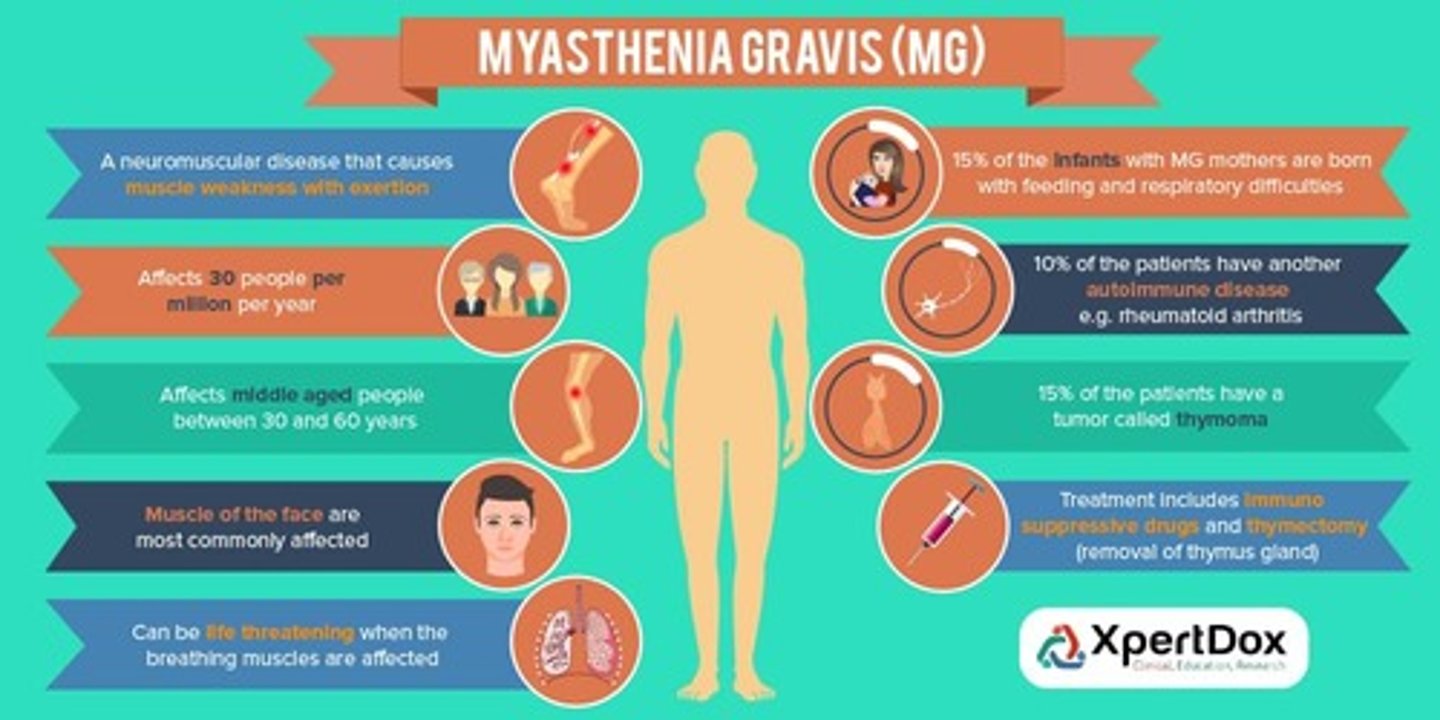
What neurotransmitter and brain part does Alzheimer's target?
NT: acetylcholine
brain part: hippocampus
What does the endocrine system do?
releases hormones and works with the autonomic nervous system to provide fight or flight reactions
What does the OXYTOCIN hormone do?
"love hormone"
- triggers feeling of love & bonding
- also vital for childbirth & lactation (producing milk)
What does the GHRELIN hormone do?
makes you hungry
[like gremlin is hungry]
What does the LEPTIN hormone do?
tells you to stop eating
What does the MELATONIN hormone do?
aids in sleep
What does the ADRENALINE hormone do?
activates sympathetic nervous system
What is an action potential? How does it occur?
> (a nerve impulse) - a brief electrical charge/message that travels/transmits down the axon of a neuron
occurs when the neuron is stimulated/fired, sending an impulse down the axon and causing depolarization, where the inside of the neuron becomes more positive.
between: chemicals
WITHIN:electricity
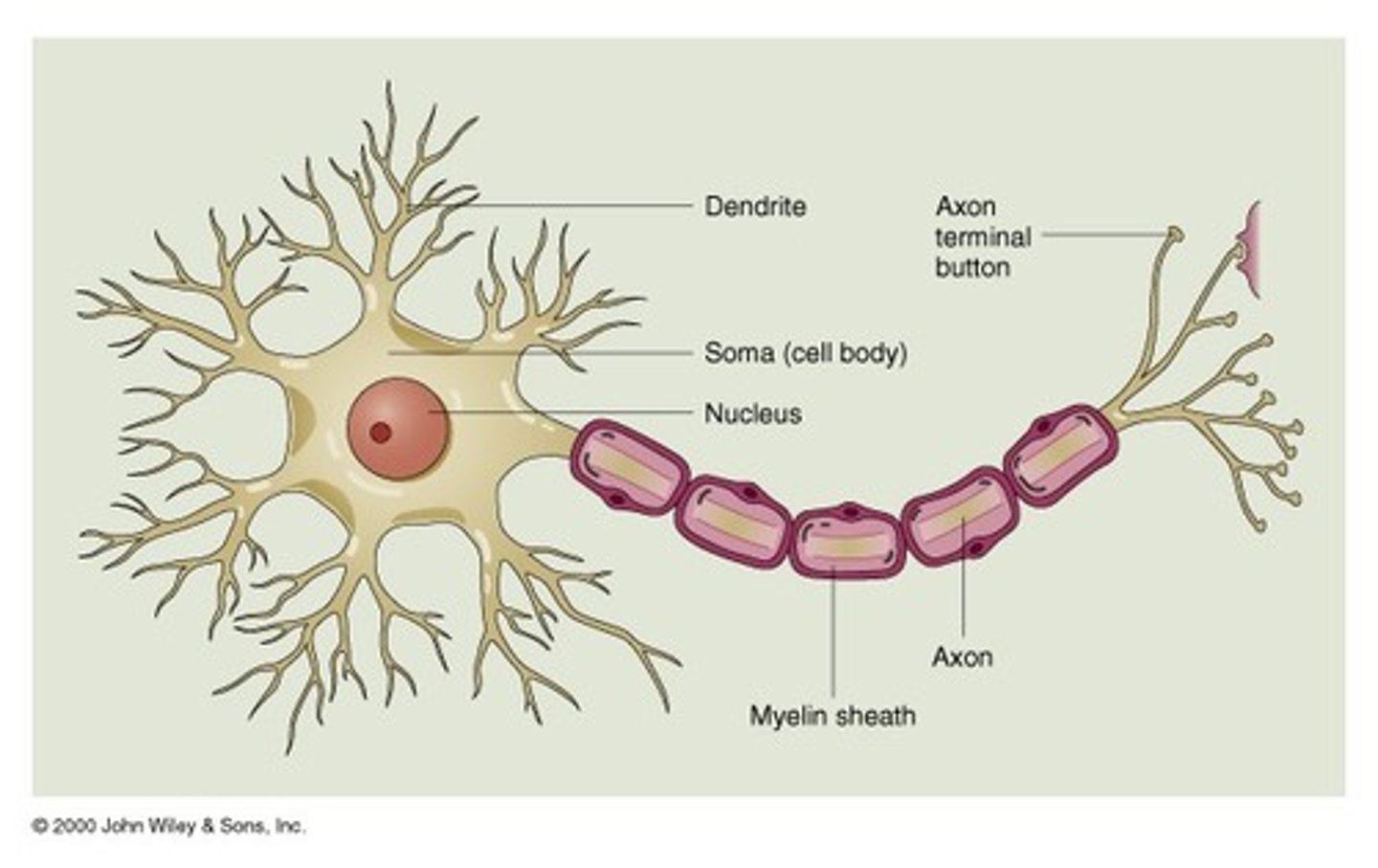
What is the threshold of excitation?
any stimulation beyond a certain level that results in a massive depolarization (flips from negative to positive)
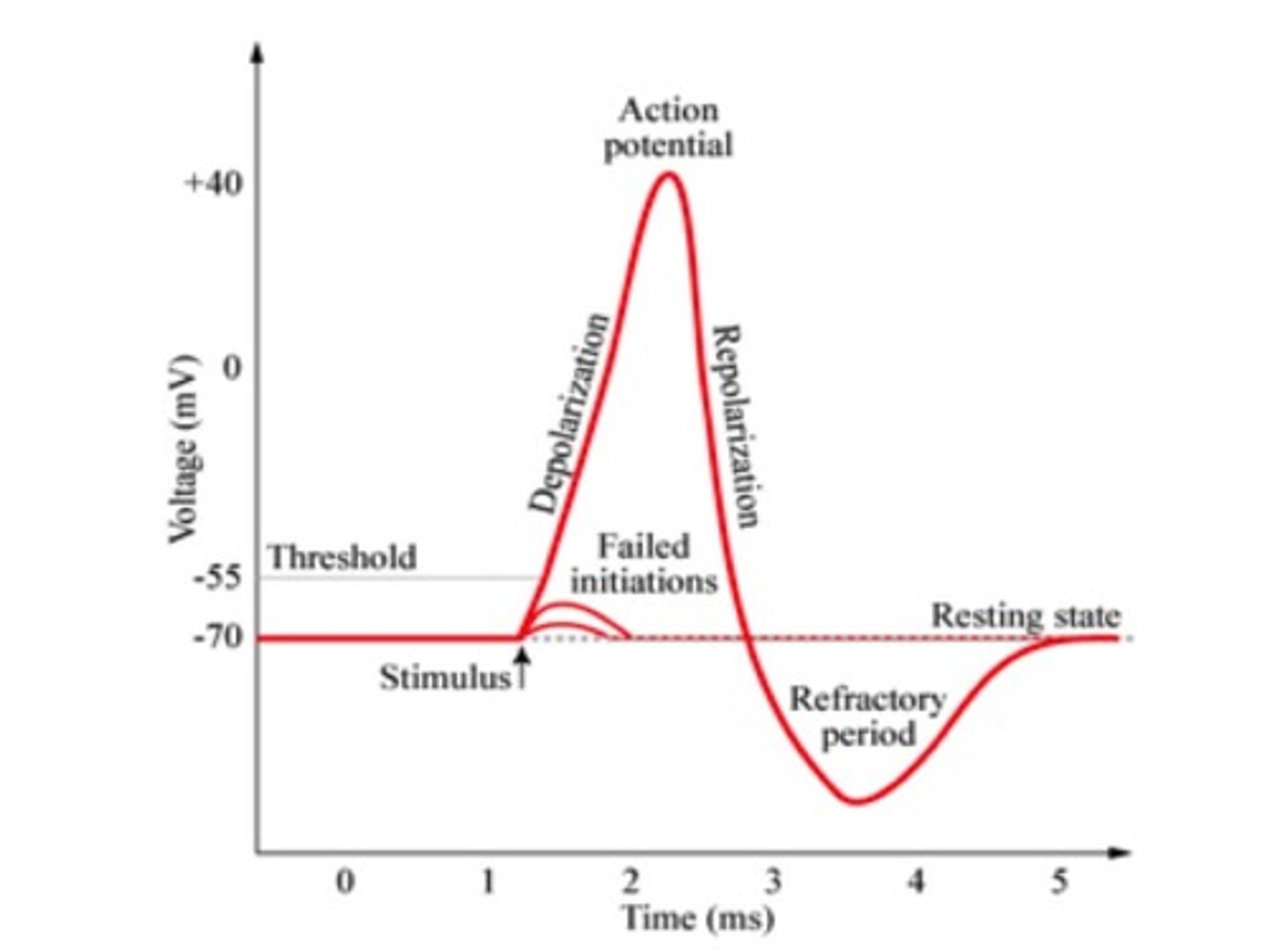
What is the resting potential?
A resting state of the neuron. It remains stable until the neuron is stimulated (-70 mV)
What is depolarization?
the negative internal charge of the cell temporarily becomes more positive (less negative)/the rapid increase in potential that occurs during an action potential in a neuron
What is the all or none law?
states that an action potential is independent of the intensity of the stimulus that initiated it
example: toilet flushes the same speed no matter what
-> action potentials are equal in intensity and speed within a given neuron
What is the refractory period?
a time the neuron resists another action potential/a state of recovery that occurs after a neuron has fired an action potential
example: toilet can't flush again until a certain amount of time
What are evolutionary psychologists?
They study how natural selection may have led to the development of certain human behaviors
What is meant by nature vs nurture? Which is the answer?
Nature = genes
Nurture = environment
answer: ALWAYS BOTH
What is the difference between identical and fraternal twins?
Identical twins: share 100% same genes (will be same sex)
Fraternal twins: share 50% same genes (can be same or different sex)
How do we use twin studies to determine nature vs nurture
If identical twins are more similar to each other than fraternal twin, then genetics play the bigger role
If they are reared a part and grow up in a different environment, we can see the influence & effects on the twins traits/behaviors
What are epigenetics
changes in gene expression due to ENVIRONMENTAL FACTORS (developmental stages + life choices)
"environmental factors can alter the expression of genes
-> referred to as epigentic tags
What do stimulants do? Give 2 examples
INCREASES central nervous system activity
- feelings of euphoria
- excessive energy
- increase motor activity (fidgety)
example: CAFFEINE, COCAINE
What do depressants do? Give 1 example
DECREASES/slows the central nervous system
(results in...)
- sedation, slowed organ functioning
- lowered inhibitions (become less shy/goes out of comfort zone)
- decrease anxiety, elevated mood
example: ALCOHOL
What do opiates do? Give example
Opioids act as PAIN KILLERS
- Endorphins = endogenous (natural) opiates
example (nonprescription opioid): HEROIN
What do hallucinogens do? Give example
make you hallucinate & alter your perception + thoughts
example: MARIJUANA
(Drugs can lead to:) What is tolerance?
user needs more of a substance to have the same effect
(Drugs can lead to:) What is addiction?
user must keep taking the drug or else they have withdrawal symptoms (addiction can be both physical and psychological)
(Drugs can lead to:) What is withdrawal?
psychological and/or physical reactions to absence of a drug
What are agonists?
facilitates (mimics) the neurotransmitters' effect
What are antagonists?
BLOCKS the neurotransmitters effect
[remember like: in eng, antagonist is BAD and will BLOCK/STOP the good characters]
What is reuptake?
the sending axon terminal reabsorbs unused neurotransmitters, to be repackaged and used again in the future
What is reuptake inhibition?
blocks the reuptake process